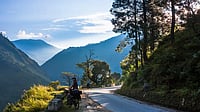Despite my prayers to the rain gods, the persistent drizzle continued. Clearly, my entreaties had fallen on deaf ears. I sat in a cosy bus, resigned to my rainy fate, ears tuned to the pitter-patter, simply awaiting my destination. It came soon after, but not before a series of bumps from the muddy road that diverted from the highway. None of it mattered, however, once I reached the Gira Falls.
Though not as large as many others in India, the falls are the jewel in Saputara’s crown. Surrounded by what seemed like an unending lush forest, they plunged ferociously into the river, producing a crash that reverberated in the woods for several seconds. This was a pleasant cacophony—one that broke the silence of the jungle.
In my tryst with Gujarat, the falls were a pit stop en route to Baj village. Just a day earlier, I could be found strolling across the bustling streets of the quaint hill town of Saputara, enjoying the many flavours of the Monsoon Festival the state tourism board was organising there. Obviously, the month-long annual event pays ode to the region’s bountiful monsoon. Also obvious is my disdain for the rains—and yet, I thoroughly enjoyed the festivities, fuelled by the exhibitions, cultural programmes, food festivals, flash mobs, and games and competitions.
As I navigated through the sea of people to reach the front, where the flash mob was performing, I was left astounded by the remarkable fervour with which the locals hailed every performance. Several instances of ‘excuse me!’ and ‘sorry!’ later, I was right where the dhol-tasha were being played. A harmony of tutaris signalled the beginning of the performance, and the drums weren’t far behind. The unrelenting energy of the performers carried over to the audience, who danced to their heart’s content. Needless to say, it was an unforgettable sight.
When Dilip Joshi, known for playing Jethalal on the popular Indian sitcom, Taarak Mehta Ka Ooltah Chashmah, took centre stage to inaugurate the festival, the audience gave him quite the cheer. Feeling lost among the overly enthusiastic congregation, I pondered upon the hero status that he had gained in Gujarat over the past decade. His every word was met with approval, every sentence with applause, and every joke with incredible laughter.
The waterfall adventure was, in contrast, a tranquil affair. Unfortunately, it had to be cut short once I realised my darkest fear—the light drizzle had become a heavy rain. Luckily, the drive to the next destination was more pleasing to the eye than I had anticipated, as the unwavering monsoon added to the raw beauty of the Western Ghats.
Baj village is a tribal settlement. The area was once home to several major tribes, such as Gamit and Kotwalia (or ‘Landlord’). Six kings traditionally ruled Saputara and its surrounding area. The British admired their valour and allowed them to rule independently as long as the tribes promised to protect the forest. Their descendants still receive an annual royalty of ₹4 lakh during Holi.
Unlike the majority of Gujarati communities, tribal food has an abundance of meat in everyday diet. While this region’s food tends to be on the sweeter side, expect the tribal dishes to be quite spicy.
A narrow, muddy road travels through the heart of Baj, with thatched and mud houses on either side. Layers of bamboo pillars support these seemingly snuggly abodes. Most have a single elongated room where the entire family sleeps. While individual privacy has lately become a hot topic of debate, the locals are close knit and discuss their problems quite openly. After a few minutes of conversation, I felt quite at home. The village children, captivated by my camera, asked me to capture their fleeting moments of happiness. I was extremely happy to oblige.
On my trip, I was able to unearth two vastly different gems of Gujarat. Baj was a tale of serenity, while the Monsoon Festival was one of absolute frenzy. Even after the sun had bid adieu and a blanket of mist had set in, the locals did not let the festivities die. The streets of the Gujarat hill station remained frenetic, as if it were some bustling metropolis.
In the evening, and as a conclusion to my sojourn, I visited Saputara Lake for a boat ride. Here, I saw the sun set behind the silhouettes of the Sahyadri and the sky go from cloudy and blue to misty and crimson. It even started to drizzle softly. This time, however, I caught myself smiling at the occasion. Quite a turnaround, wasn’t it?
Gujarat’s premier hill station Saputara is a five–seven hour car ride from its cultural capital Baroda. Protected by the Sahyadri mountains, this is a land of awe-inspiring beauty during the monsoon, which is at its peak between late July and early September.

























